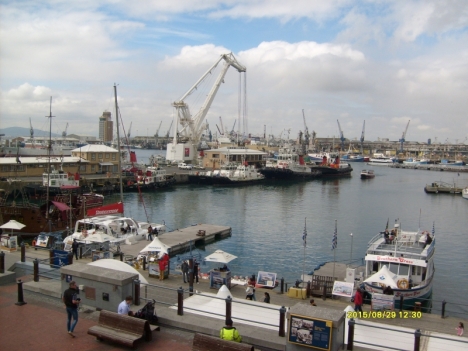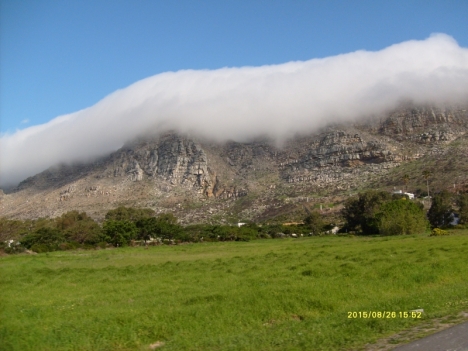A couple of weeks ago Micha Hannemann, Val’s fifth cousin once removed on the Flamme side of the family, got in touch through a link found on the web, and now we have met Micha, her parents, Michael and Irene Birch, and Micha’s daughter Andrea. We compared notes on the family history, reaching back to Francina van de Kaap, slave of Pieter Hacker.
Irene’s mother, Johanna Maria Weilbach (born Steytler) had died last July at the age of 100, and they had found all kinds of family treasures, including portraits of the common ancestors, Johan Friedrich Wilhelm Flamme (1780-1831) and Johanna Sophia Breedschoe (1782-1836), and the commonplace book of their eldest daughter, Francina Dorothea Flamme, who married first Jonathan Joseph Burnard, and second Gerhardus Nicolaas Mechau, a Cape Town butcher.

Flamme cousins: Val Hayes, Irene Birch, Andrea Hannemann, Micha Hannemann, Michael Birch, 7 December 2018, Pretoria
The commonplace book was a historical treasure in itself, containing pictures of early Cape Town, and helping to clarify some family relationships that have long been a puzzle. One member of the the family, Anna Mechau, had been an artist, and here is one of the pictures she had drawn in the commonplace book:
And here is an unsigned picture of a Cape Town scene, probably around the same time, or a little earlier:
There were many snippets of poetry and drawings, some signed with names, some more obscurely by initials, and some just signed “A Friend”.
But best of all were two portraits of Val and Micha’s common ancestors, J.F.W. Flamme and Johanna Sophia Breedschoe (or Breitschuh).
Johan Freidrich Wilhelm Flamme was born on 3 October 1780 in Twiste, Hesse-Nassau, Germany, the son of Stephan Flamme and Maria Elisabeth Scharschmidt. He came to the Cape Colony as a soldier in the Waldeck Regiment, and was captured during the British occupation and confined in Fort Amsterdam. He may have worked as an assistant to John Martin Durr, butcher, who gave surety for him in 1806, and wrote to the Governor and Commander in Chief of His Britannick Majesty’s troops in the Settlement of the Cape of Good Hope, Sir David Baird, saying that his “very extensive Butcher’s trade necessitates him always to have in his service a number of assistants either to dispatch the daily business of the Butchery or to go up into the country to buy for him the Cattle necessary for the Inhabitants of the Town as well as for the Ships in the Road”
Durr went on to say that he “had happily found out a certain Frederick William Flamme, formerly Soldier in the Batallion of Waldeck, who is still confined at Fort Amsterdam, and is ready to become your Petitioner’s Assistant, provided Your Excellency grant him leave for it.”
On 1 January 1809 Johan Friedrich Wilhelm Flamme married Johanna Sophia Breedschoe and in 1817 he applied for citizenship. They had 11 children, though several of them died young.
Johanna Sophia Breedschoe was the daughter of another soldier, Johan Christoph Franciscus Breitschuh, who arrived in the Cape Colony in 1773 from Halle in Germany, and also worked as a carpenter. He had two children by Francina van de Kaap who was a slave of Pieter Hacker. He had the children manumitted in 1787, and possibly their mother had died by then.
Their eldest daughter Francina Dorothea Flamme (the one who kept the commonplace book) married Jonathan Joseph Burnard, but he was killed in a carriage accident, and her second marriage was to Gerhardus Nicolaas Mechau, whose mother Anna Mechau (born Jacobs) was the artist who filled the commonplace book with pictures, and presumably also painted the portraits of Francina’s parents.
There are many Mechau descendants that we have managed to trace.
Val’s great great great grand mother was a younger daughter of J.F.W. Flamma and Johanna Sophia Breedschoe. She was Petronella Francina Dorothea Flamme (1822-1893) who married Henry Crighton (1815-1870), and they too had numerous descendants.
The Flamme boys mostly died young, and so there are no cousins with the Flamme surname in southern Africa, but apart from the Burnard, Mechau and Crighton descendants, the other Flamme girls married into the Wright, Beningfield, Laing, and Tait families.
Filed under: Crighton family, family history, genealogy | Tagged: Cape Town, commonplace book, Flamme family, local history | Leave a comment »




























